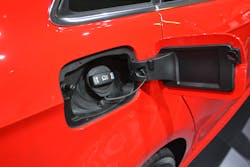University of Extrication: Plug-In Vehicle Identification
Subject: Plug-In Vehicle Identification
Topic: Charging Port Size-Up
Objective: Understand the importance of determining if a charging port is present on a plug-in hybrid or electric vehicle.
Task: The rescue team shall inspect the exterior of a given vehicle and determine if it is an internal combustion engine vehicle, a hybrid, plug-in hybrid, or electric plug-in vehicle.
In all of the available responder training programs on dealing with hybrid and electric vehicles (EVs), one common teaching point that is emphasized is the importance of quickly identifying whether the vehicle involved at the emergency scene is a hybrid or electric vehicle. Identification begins with an exterior size-up started during approach to the scene. It continues as the first-due officer completes a 360-degree walk-around of each damaged vehicle. One obvious size-up clue that rescue officers look for is hybrid or electric vehicle “badging”—emblems attached to the exterior of the vehicle.
In addition to exterior badging, which may or may not be visible when you arrive, there is an additional feature to look for during your exterior vehicle size-up—small doors on the sides, front or rear of the vehicle. These small doors or covers conceal the fuel-filler neck for internal combustion engines or the vehicle's electric charging receptacles for its high-voltage battery.
To further explain, let’s complete a 360 of a late-model vehicle and see what we might find. First, we encounter one door that when popped open, reveals the typical fuel-filler port for adding gasoline or diesel fuel. Don’t stop there, though; complete your size-up looking for any additional hybrid or EV clues.
Like a typical internal combustion engine vehicle, a hybrid vehicle will only have this one small door—the fuel filler door. A newer plug-in hybrid, however, will have a fuel filler door as well as an additional door somewhere else on the vehicle for charging its high-voltage battery.
Just one small door on the exterior of the vehicle can also indicate that you have a plug-in electric vehicle such as a Tesla Model S. There is no internal combustion engine on these vehicles, so this one small door covers the electrical charging port. Remember, if the vehicle at your incident scene is an electric plug-in vehicle, it will only have one charging port door.
As we continue around our vehicle, however, we could also discover a second small door—this time on a side fender or quarter panel. Opening this door reveals the receptacle where the power cable is plugged in to charge the high-voltage battery. If the first door was the fuel filler door and there is a second small door on the same vehicle, you now know you’re dealing with either a plug-in hybrid or an extended-range electric plug-in vehicle, such as the Chevrolet VOLT.
Rescue officers must realize that charging port doors may not be just on the side of the vehicle; they can be at the rear or at the very front of the vehicle. Mercedes-Benz plug-in vehicles have their small charging port door on their rear bumper. The Nissan LEAF has its charging port at the very front of the hood. The Audi A3 e-tron electric vehicle has its charging port concealed behind the Audi logo on the front grill.
An alert rescue officer should be looking for, counting and popping open these small doors. You need to see what’s behind each door; is it the fuel fill neck opening or the electrical charging port?
Small Door Size-Up
One Small Door Only: If this opens to reveal a fuel-filler tank, then this is a gasoline- or diesel-powered engine vehicle.
One Small Door Only: If this door opens to reveal a charging port for a high-voltage battery, then this vehicle is a plug-in electric vehicle (i.e., Nissan LEAF, Tesla Model S).
Two Small Doors: If a second small door is present, then the vehicle is either a plug-in hybrid (i.e. Toyota Prius Plug-In) or an extended range electric plug-in vehicle (i.e. Chevy VOLT).
About the Author
Ron Moore
RON MOORE, who is a Firehouse contributing editor, recently retired as a division chief with the McKinney, TX, Fire Department and now serves with Prosper, TX, Fire Rescue. He self-published the Vehicle Rescue 1-2-3 training manual and serves as the forum moderator for the extrication section of Firehouse.com . Moore can be contacted directly at [email protected].

